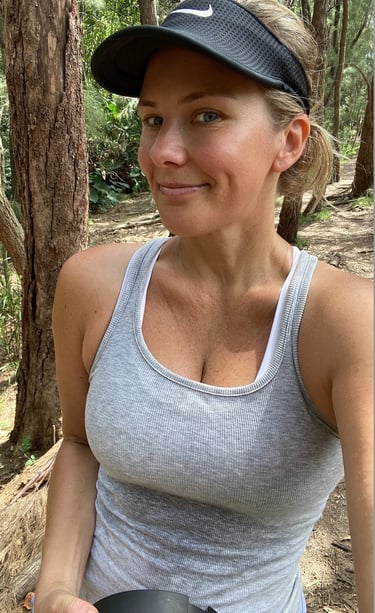Breathwork it's more than breathing
MINDSETHEALTH SCIENCE
Written by Rachel Mehaffey


Breathwork, why I love it as a Coach
But it is just breathing.. No. Breathing and Breathwork are different in so many ways. While both can be autonomic responses (things you do without having to think about it), breathwork is using the specific sequence of breath to influence the body & its physiological functions.
Look its not new. While there is a lot of promotion around the practice as something new age the reality is it's been around since the dawn of our days. how do i know - child birth. Women have been using the practice of breathing to get them through the most strenuous act a body will ever go through - bringing a child into this world. The name given is lamaze breathing but it is simply a form of breathwork.
I discovered breathwork not because it was for me but, my girl. See Poppy suffers from anxiety, she has since she was about 5 and her panic attacks kicked in around the age of 8. It is easy to dismiss a child with behaviours thinking 'what do that have to stress about' but believe me, they have their own little mountains to climb.
So I went searching for something she could master to take back control. Where she didn't have to rely on being with me to feel better and knew she had in her toolkit to take away the anxiety of having anxiety. But why does it work? Let's take a look at the foundations of breathing first.
The Foundations & Science Behind Breath:
The Science of Breathwork and Its Impact on the Nervous System
Breathwork is a powerful tool that can significantly influence the nervous system. Breath itself is the way we inhale O2 to oxygenate the body tissues through the haemoglobin (oxygen carrying red blood cells) and exhale CO2 (carbon dioxide). To keep it simple, by manipulating the amount, cycle, power of breaths we can diretly impact the physiological processes in the body.
Ok let's help to understand lets take a basic look at how the body and lungs function, the role of oxygenation, and how different breathwork techniques yield various outcomes.
The Body, Lungs, and Oxygenation
1. Basic Anatomy and Physiology:
Lungs: The lungs are two spongy organs located in the chest cavity. Their primary function is to facilitate gas exchange between the external environment and the bloodstream.
Alveoli: Tiny air sacs in the lungs called alveoli are where oxygen from the air we breathe is exchanged for carbon dioxide, a waste product of metabolism.
Diaphragm: The diaphragm, a dome-shaped muscle located at the base of the lungs, plays a crucial role in breathing. When the diaphragm contracts, it creates a vacuum that pulls air into the lungs. When it relaxes, air is expelled.
2. Oxygenation Process:
Inhalation: During inhalation, oxygen-rich air enters the alveoli. Oxygen diffuses through the alveolar walls into the surrounding capillaries and binds to hemoglobin in red blood cells. This oxygenated blood is then transported throughout the body to fuel cellular processes.
Exhalation: Carbon dioxide, produced by cells as a metabolic waste product, is transported back to the lungs via the bloodstream. It diffuses from the blood into the alveoli and is expelled from the body during exhalation.
Breathwork and the Nervous System
The nervous system is divided into two main parts: the central nervous system (CNS) and the peripheral nervous system (PNS). The autonomic nervous system (ANS), a component of the PNS, regulates involuntary bodily functions and is subdivided into the sympathetic nervous system (SNS) and the parasympathetic nervous system (PNS).
1. Sympathetic Nervous System (SNS):
Often referred to as the "fight or flight" system, the SNS prepares the body to respond to perceived threats. It increases heart rate, dilates airways, and releases stress hormones like adrenaline.
2. Parasympathetic Nervous System (PNS):
Known as the "rest and digest" system, the PNS promotes relaxation and recovery. It decreases heart rate, constricts airways, and stimulates digestion.
But what is the difference between breathwork and just breathing:
Breathwork involves playing around with your inhales and exhales, teasing your nervous system to shift gears into an ideal state. You could want to stress less, invigorate to workout or wind for sleep. Here are the most common types of breathwork.
Diaphragmatic Breathing
Otherwise coined Deep breathing gets you up close and personal working with your belly, because this technique tickles your diaphragm—a superstar muscle just beneath your lungs. By breathing deeply into your tummy, you awaken the chill-out mode of your nervous system, waving goodbye to stress and embracing relaxation like a hammock in the summer breeze.
Technique: Breathe deeply into the diaphragm rather than shallowly into the chest. This can be done by inhaling slowly through the nose, allowing the abdomen to expand, and exhaling slowly through the mouth.
Outcome: Activates the PNS, promoting relaxation, reducing stress and anxiety, and improving focus.
Alternate Nostril Breathing
Prepare to become a nose ninja! This technique lets you play the inhalation-exhalation game, hopping between left and right nostrils like a graceful dancer. It's a brain power booster, balancing the energy in your noggin and harmonizing your emotions like a perfectly synchronized orchestra.
Technique: Involves inhaling through one nostril while closing the other with a finger, then exhaling through the opposite nostril while closing the first.
Outcome: Balances the left and right hemispheres of the brain, reduces stress, and enhances mental clarity and focus.
Box Breathing
Let's think inside the box! Box breathing, the Picasso of breathwork, involves inhaling, holding your breath, exhaling, and holding it again—all for the same amount of time. It's a ticket to serenity, magically banishing anxiety, calming the mind, and sharpening your focus like a Zen warrior.
Technique: Involves inhaling for a count of four, holding the breath for a count of four, exhaling for a count of four, and holding the breath for a count of four again.
Outcome: Balances the SNS and PNS, improving mental clarity, enhancing concentration, and reducing stress.
Rapid Breathing (e.g., Kapalabhati)
Rapid breathing techniques, such as Kapalabhati, involve forceful exhalations followed by passive inhalations, enhancing lung capacity and respiratory efficiency. This practice stimulates the sympathetic nervous system, increasing alertness and energy levels while purifying the respiratory system by clearing out mucus. The increased oxygen supply improves mental clarity, reduces fatigue, and promotes emotional stability. By engaging and strengthening the respiratory muscles, rapid breathing offers significant physical and mental benefits, making it an effective tool for boosting vitality and focus.
Technique: Involves rapid, forceful exhalations followed by passive inhalations.
Outcome: Stimulates the SNS, increasing alertness and energy levels. It can also help in clearing nasal passages and improving lung capacity.
4-7-8 Breathing
Developed by Dr. Andrew Weil, involves inhaling for four counts, holding the breath for seven counts, and exhaling for eight counts. This method activates the parasympathetic nervous system, promoting relaxation, reducing stress, and regulating heart rate. It enhances oxygenation and improves sleep quality, making it a powerful tool for managing anxiety and insomnia. By practicing this technique regularly, individuals can achieve greater calm, better focus, and improved emotional stability, contributing to overall well-being.
Technique: Involves inhaling for a count of four, holding the breath for a count of seven, and exhaling for a count of eight.
Outcome: Strongly activates the PNS, promoting deep relaxation and aiding in sleep.
So what is so important about breath and how do I know if i am doing it right?
Correct breathing technique is vital because it ensures efficient oxygenation of the body, and if not optimised, improper breathing can lead to health issues like increased stress, anxiety, fatigue, decreased lung function, and a compromised immune system.
Breathwork influences the nervous system by modulating the balance between the sympathetic and parasympathetic nervous systems. Different techniques can either stimulate the body, promoting alertness and energy, or calm the body, reducing stress and promoting relaxation. By understanding the science behind breathwork, we can harness these techniques to improve our mental and physical well-being
So why do I recommend (and use it myself) as a Life Coach
Because it’s a game-changer for both your body and mind. It is having a tool that not only boosts your energy but also helps you stay calm and focused—breathwork does just that!
Physical Health Benefits
Breathwork helps your lungs work better, ensuring your body gets all the oxygen it needs. This extra oxygen boosts your energy, fights off fatigue, and helps your body detox naturally. Techniques like rapid breathing (Kapalabhati) strengthen your respiratory muscles, making your lungs healthier and more efficient.
Mental Clarity and Focus
Need to clear your mind and sharpen your focus? Breathwork is your go-to. Rapid breathing wakes up your nervous system, making you more alert and mentally sharp. Meanwhile, methods like 4-7-8 breathing calm your nerves, reduce stress, and help you stay balanced. It’s like having a mental reset button whenever you need it.
Stress Reduction and Emotional Balance
Breathwork is a fantastic way to manage stress and anxiety. The 4-7-8 technique, for instance, helps calm your mind and body, reducing stress hormones and regulating your heart rate. Regular practice can lead to greater emotional stability and a more positive outlook, making it easier to handle whatever life throws your way.
Better Sleep
Struggling with sleep? Breathwork can help. Techniques that promote relaxation, like 4-7-8 breathing, can improve your sleep quality by calming your nervous system and preparing your body for a good night’s rest. Say goodbye to tossing and turning!
Overall Well-Being
Incorporating breathwork into your daily routine is a simple yet powerful way to improve your overall well-being. It bridges the gap between physical and mental health, providing benefits that cater to a variety of needs. Whether you want more energy, better focus, less stress, or improved sleep, breathwork has got you covered.
For me it was a game changer not only to help keep me in the present when my mind wanted to run off into the past or sprint into the future but as a helper for Poppy, my daughter. She suffers from anxiety and it was debilitating.
Breath can help anyone of any age anywhere and at any time. It is a universal tool and simply learning it puts you in the driver's seat of your nervous system. I recommend the breath assessment by Emma Ferris (right) if you want to check your breath or the app BreathWrk on the app store for guided support while you are learning (there is a free version).
I use it everyday, so does Poppy and I truly believe in the benefits. For more reading on the foundations of the techniques my top reads are in the Stash (link to the right) on benable. I use the techniques in my Mindset Reset Program when looking at how we can reframe our subconscious mind because the breath helps us to recruit the CNS to help us connect with the mind and body in the reporagram.
Have questions? Get in touch for a chat! I love this topic - like a lot. Want to use it, take a look at the reset program.
Keep It Simple - Sugar
Rach xx


Hey, I'm Rach. I'm a Life Coach, Podcaster, Digital Course Creator, Writer, Educator, Single Mum & Science Nerd.
I started coaching for interest sake then left my 20 year Big Corporate Gig to make it my life's work. Now I'm helping people all over the globe with mindset & teaching how to access the life you want.
Subscriber
Like to learn? Subscribe to my tribe here, pick your topic and get weekly updates on new blog posts direct to your inbox.
My Top Picks On The Blog
Mindset
Mind Body Connect
I love sharing what I know. All the tips, tricks and techniques we learn coaching & sharing how to use them yourself. Coach Candour pages are like you own in home coach on all topics body, mind & life.
I believe in authenticity and show up that way every day. The personal shars of the good, the embarrassing & the funny so you know everyone is relatable when it comes to the journey of life.
All about the thing I love most - science of the mind meshed with the inner workings of the body & how you can take back control of your subconscious.
The mindset pages are designed to share real life experiences we all have on mental health & give you practical advice & steps you can take to start to heal & create your new narrative.
As a sports scientist and pilates instructor there is so much to offer learning about breathwork. I have catalogued the best reads for your to browse.
I love Benable for this! It lets me create a collection you can scroll in one place without a million links.
psst.. it's referral only, get your own shareable lists
READ more on THE BLOG
A MINDSET RESET
The Subconscious Reset Aimed at Self Sabotage
Say hi to the self that’s been hiding.
Mindset is your most powerful muscle. I'm sure you've heard the term 'mind over matter' many times. But what if I told you it's true..
We take care of the body, it's time to prioritise the mind.




Before you dive in ... Hey, I'm Rach!
I'm your in home life coach, a nerd when it comes to the body & mind. My vibe is teaching you how to thrive.
An Adelaide born life coach, podcaster, educator & dog obsessed animal lover. My purpose is giving you the tools to Level Up your life. I'm so happy you are here.


Coach & Friend -
Can we please?
A writer at heart hankering to be your pen pal! Allergic to junk mail I send only what you benefit from. Real strategies, workshop style challenges, unwavering encouragement & things you didnt know (but soooo... want to) - Direct to your inbox. You in?
Free tools to start your Life Level Up
FREEBIES


Downloads




















